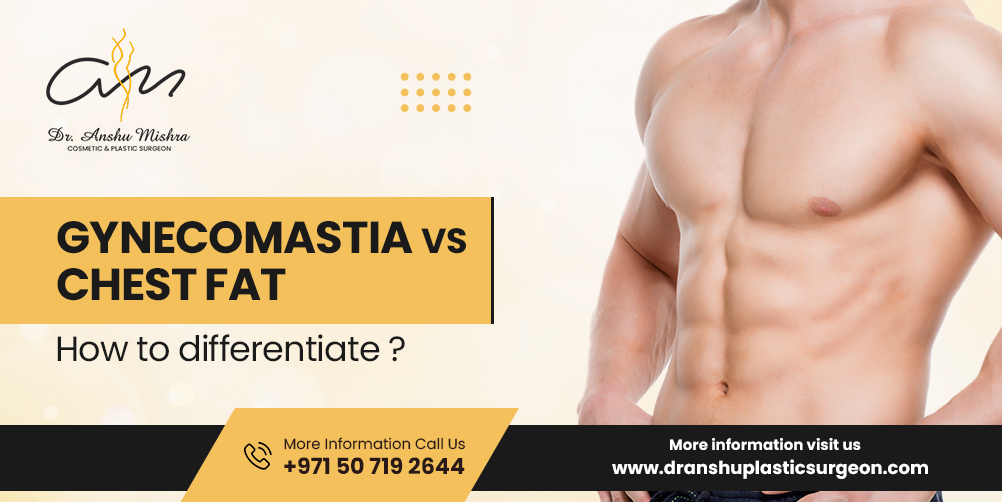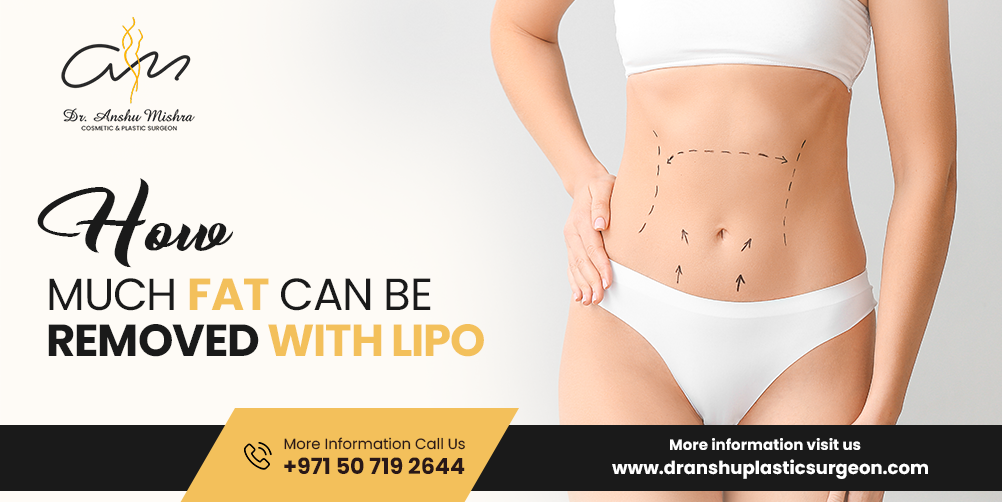Who doesn’t want a well-built and perfectly defined body? We see lots of men spending time in the gym working out and shaping their bodies, especially the upper body aiming to get a well-defined chest, yet most adolescent men often struggle with gynecomastia and chest fat. These conditions cause intense anxiety and discomfort among the male population. At this moment it is important to understand their differences, causes, and treatment to make an informed decision about your health and body. In this Dr Anshu Mishra blog post, we’ll explore what gynecomastia and chest fat are, their causes, and treatment to achieve the best results.
Table of Contents
ToggleWhat is Gynecomastia?
Gynecomastia is a medical condition where male breast tissue becomes enlarged. It’s a rapidly growing issue, affecting up to 70% of adolescent boys during puberty and around 65% of men in their late 30’s and 40’s. Gynecomastia can occur in one or both breasts. It appears as a firm, rubbery mass under the nipple area. This unusual change in physical appearance impacts the psychological well-being of men and lowers their confidence level.Causes of Gynecomastia
The primary cause of gynecomastia is an imbalance between estrogen (female hormone) and testosterone (male hormone). Here are some common reasons for this imbalance:- Puberty: Hormonal changes during puberty are a natural process, but sometimes hormonal imbalance triggers temporary gynecomastia in puberty.
- Aging: As you age hormonal changes occur, including the decline in testosterone levels and an increase in estrogen, which can lead to gynecomastia in aged men.
- Medications: Sometimes certain drugs, such as anti-androgens, anabolic steroids, and some antidepressants, can cause gynecomastia.
- Health Conditions: Some health conditions also disrupt hormonal levels and cause gynecomastia such as liver disease, kidney failure, and hyperthyroidism.
- Substance Use: Alcohol, marijuana, and other recreational drugs can contribute to hormonal imbalances.
What is Chest Fat?
Increased chest fat, also known as pseudo-gynecomastia, is simply the accumulation of fat in the chest area. It’s different from gynecomastia, chest fat doesn’t involve the growth of breast tissue. Instead, it occurs because of overall weight gain and can affect men of all ages.Causes of Chest Fat
The reasons for chest fat are naturally related to lifestyle and genetics:- Diet: Diet plays an important role in weight management. Consuming a high-calorie diet, especially full of unhealthy fats and sugars, can lead to weight gain and fat accumulation in the chest.
- Exercise: An inactive lifestyle can lead to weight gain and fat buildup in various parts of the body, including the chest.
- Genetics: In a few cases men are genetically inclined to accumulate fat in their chest area.
- Hormonal Imbalance: Though it’s a less common hormonal issue can also lead to fat stock in the chest area.
Symptoms and Diagnosis
Symptoms of Gynecomastia- A firm, rubbery lump under the nipple area
- Breast tenderness
- Swelling in one or both breasts
Symptoms of Chest Fat
- Soft, fatty tissue in the chest area
- Lack of a distinct lump under the nipple
- Fat accumulation but no breast tenderness
How to Diagnose Gynecomastia and Chest Fat
If you are experiencing enlargement of your chest and you are unsure whether you have gynecomastia or chest fat, you must visit a doctor to confirm. The doctor will conduct a physical examination and may run a few tests such as:- Blood Tests: To check hormone levels.
- Imaging Tests: Ultrasound or mammogram to distinguish between fat and glandular tissue.
- Biopsy: In rare cases, a tissue sample may be taken to rule out other conditions.
Treatment Options
Treating Gynecomastia
- Medication: If hormonal imbalance is causing gynecomastia, doctors will prescribe medication for hormone level adjustment. These pills help to control changes in hormone levels.
- Surgery: In severe or persistent cases where medication is not effective, doctors will suggest surgical procedures like liposuction (to remove excess fat) and excision of glandular tissue.
- Lifestyle Changes: Sometimes making changes in lifestyle can cure gynecomastia. Reducing alcohol, avoiding recreational drugs, and reviewing medications with your doctor would help in managing gynecomastia.
Chest Fat Treatment
- Diet and Exercise: Reducing accumulated fat is easy with a balanced diet rich with nutrients and regular exercise can miraculously reduce chest fat. You should focus on cardio and strength training for targeted chest areas.
- Weight Loss: Aim for weight loss, which targets excess fat in the overall body including the chest area.
- Surgical Options: In a few cases diet and exercise aren’t enough, then doctors may suggest liposuction as an effective treatment to remove excess chest fat.
Tips for Reducing Chest Fat
Diet Tips
- Balanced Diet: A balanced diet filled with whole foods such as fruits, vegetables, lean proteins, and whole grains is helpful in reducing unhealthy fat.
- Sugar and Refined Carbs: You should cut the sugar and refined carbs completely from your meals. These are the major sources of weight gain and fat accumulation.
- Stay Hydrated: Our body is made up of 70% water, which is essential for good health and glowing skin. Drink plenty of water to support your metabolism.
- Limit Alcohol: Consuming alcohol is not good for your body if you are struggling with medical conditions. Alcoholic drinks are full of calories and can contribute to weight gain.
Exercise Tips
- Cardio Workouts: Cardio workouts are best for fat reduction. Activities like running, cycling, and swimming can help burn overall body fat.
- Strength Training: Strength training focuses on targeted exercise for the upper or lower body. You can opt for a chest workout, such as push-ups, bench presses, and dumbbell fly.
- Consistency is Key: Following a healthy regime regularly, combined with a balanced diet, is crucial for long-term success.
Psychological Impact
Physical appearance plays a crucial role in our confidence and psychological well-being. Both gynecomastia and chest fat can impact men psychologically . Feelings of embarrassment, anxiety, and low self-esteem are common. It’s imperative to address these feelings and seek support if required.Seeking Support
- Therapy: Consultation with mental health professionals can help in dealing with emotions and boost your confidence.
- Join Support Groups: Gynecomastia and chest fat cases are increasing rapidly, and there are millions of individuals facing such conditions. Connecting with others who have similar experiences can be comforting.
- Connect with Friends and Family: Friends and family are there for support, sharing your concerns with loved ones can provide emotional support.
When To Consult a Doctor?
If an individual experiences an unusual change in the chest area, like an enlarged breast with a firm rubbery mass, and fatty chest, it’s time to visit a cosmetic surgeon to understand the reason behind these changes. If hormonal imbalance is causing this condition, then chances are high to have a gynecomastia and if it’s a normal weight gain issue then probably it is causing chest fat. Once symptoms are identified then the next step would be deciding the issue and then the doctor will choose the right procedure depending upon the condition and individual symptoms and goals.If You Have Gynecomastia
- Seek Medical Advice: Whenever you feel some changes in your chest area or symptoms of gynecomastia, the first step is to find an expert medical surgeon and consult to explore treatment options for your condition.
- Consider Surgery: In most cases, medication and changes in lifestyle give positive results. If your case is severe, consider exploring surgical procedures to achieve the desired result, doctors will suggest better.
If You Have Chest Fat
- Lifestyle Changes: Adopting a healthy lifestyle, diet, and exercise helps lose chest fat significantly.
- Non-Surgical Options: First go for non-invasive methods, if required then consider surgical procedures.
Conclusion
Understanding the difference between gynecomastia and chest fat is the first step, consulting with a doctor and exploring options for treatment is the next step. Whether it’s a hormonal imbalance or accumulated fat, there are expert surgeons available in the market to provide proper guidance and suggest the best treatment. By seeking medical advice, changing your lifestyle, and deciding what you want to achieve, you can get a well-defined chest and improved confidence and well-being. Whether you’re dealing with gynecomastia or chest fat, there’s a solution that can help you feel more comfortable and confident in your body. Most men are experiencing such conditions because of lifestyle changes and environmental factors that cause hormonal imbalances. Junk food is also contributing to unhealthy fat gain and chest fat condition. Dr Anshu Mishra is an expert in Gynecomastia and chest fat treatment and runs a clinic in Dubai. If you are looking for the best surgeon for Gynecomastia and chest fat and want to have a second opinion you can visit her. After a thorough examination, she offers the best possible solution for any problem. She is one of the best plastic surgeons in Dubai and performed various cosmetic surgeries. Her expertise in Gynecomastia and chest fat treatment makes her the best choice for anyone looking to get the surgery done. Dr Mishra ensures patient’s safety while delivering positive results. She suggests the best options to achieve the patient’s goal. With 11 years of experience in surgery, she has treated many patients successfully. If you want to get a consultation in Dubai, look no further and visit Dr Anshu Mishra for best results.FAQ
-
How can chest fat and gynaecomastia be distinguished from one another?
-
When compared to chest fat, what are the causes of gynecomastia?
-
Comparing gynaecomastia to chest fat, how is it diagnosed?
-
What are the possibilities for treating gynaecomastia and may it resolve on its own?
-
When should you see a physician if you have chest obesity or gynecomastia?
-
Can gynecomastia and chest fat occur together?















